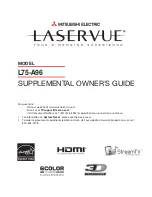
18
LC-39/50LE750
LC-39/50LE751
LC-39/50LE752
NOTE
•
The value of
Frequency
and
Network ID
should
be set to the value specified by the cable provider.
Press
J
to continue.
If you have not selected a DVB-S antenna in the
antenna selection, continue with
Settings for all types
of reception
on page 13.
Select the satellite system.
Specify how you receive which satellite(s) (single
satellite or type of satellite system). Ask your dealer in
this regard.
The normal DVB-S settings are derived from the
selection of the location and do not need to be changed
in most cases.
Ɣ
Single satellite
Reception of a single satellite via a connected LNC
(LNB). See page 11 for settings.
Ɣ
2 satellites on 22kHz switchbox
Reception of two different satellites with two LNCs
(LNBs) which are connected to the TV set by a 22
kHz switchbox. See page 11 for settings.
Ɣ
2 satellites on Toneburst switch
Reception of two different satellites with two LNCs
(LNBs) which are connected to the TV set by a
toneburst switch. See page 11 for settings.
Ɣ
Max. 4 satellites on DiSEqC multiswitch
The TV set controls a DiSEqC multiswitch to which
up to four LNCs (LNBs) for different satellites are
connected. See page 11 for settings.
Ɣ
DiSEqC one cable communal system
Select setting if the TV set is connected to a DiSEqC
single cable system (according to EN50494). Several
satellite receivers can be connected to one satellite
cable. See page 12 for settings.
Ɣ
Other communal installation
Select this setting if the TV set is connected to a
single-cable system (without DiSEqC). Several
satellite receivers can be connected to one satellite
cable. As opposed to a DiSEqC one cable system
there are restrictions in the range of certain reception
frequencies in common single-cable community
systems. See page 13 for settings.
Press
J
to continue
Quick guide
If you have not selected DVB-C antenna in the
antenna selection, continue with
Setting options for
DVB-S reception
below.
The normal DVB-C settings are derived from the
selection of the location and do not need to be changed.
Press
Ÿ
/
ź
/
Ż
/
Ź
to change each item to the appropriate
settings:
Ɣ
Ɣ
Network selection
If several networks are available via DVB-C, you
can decide which network you want to receive your
channels from.
Ɣ
Ɣ
Scrambled stations
You can specify if coded stations are to be searched
for in the search/update.
Select
yes
to save all scrambled stations.
•
These stations can only be received in connection with a CI
module and the appropriate CA Card.
•
If a CI module with a CA Card is already inserted for the station
search, all the stations which this module can descramble are
also saved when
no
is selected.
Ɣ
Ɣ
Search method
If you select
Frequency Search,
a search is
performed for all receivable stations. With
Network
Search
, only the stations which the networks
supply are searched, either for all receivable
networks or only for the particular network specified
under
Network ID.
Ɣ
Ɣ
Start
Frequency
The DVB stations are only searched for in the
frequency range above the start frequency.
Ɣ
Ɣ
Network ID
Change this setting to register only the specified
network ID.
Ɣ
Ɣ
Accept logical channel number
In various countries, digital stations are transmitted
with a preset channel number per station, known as
"Logical Channel Numbers" (LCN).
If you select
yes
, these default channel numbers will
be used and the channels will be sorted as per LCN.
8
Supplying power to the antenna.
If you use a DVB-T antenna that requires a supply voltage
and which is not supplied via a power adapter, then select
yes (5V)
for the antenna's power supply.
Press
J
button.
How to align your DVB-T antenna is described on
page 14.
9
Continue with
Settings for all types of reception
(See page 13).
Setting options for DVB-C reception
Setting options for DVB-S reception
Operation Manual (Continued)
















































